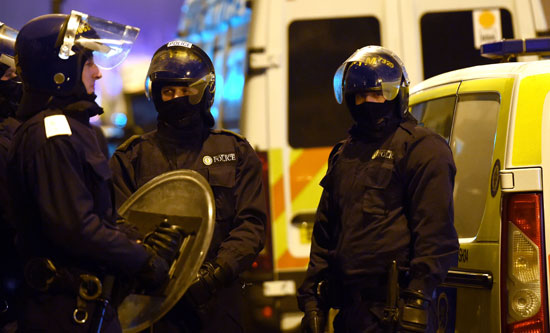
‘Tornado team’ is the term used to describe the squads of prison officers who are used to break up riots and disturbances. In the past they were known as C&R teams or the MUFTI squad and had a reputation for extreme brutality towards prisoners.
In the early hours of Thursday 12 October, ‘Tornado team’ prison staff were sent in to E wing of high security Long Lartin prison in Evesham, Worcestershire to forcibly end a protest which had begun the previous evening.
A life sentence prisoner gave this account of events on E Wing in to the Miscarriages of Justice UK (MOJUK) organisation:
‘The disturbance was down to three prisoners trying to air their frustration at being kept on Basic for long periods of time. They asked to see the governor etc but were denied. They refused to go behind bars at lockup on Wednesday 11 October and then caused a disturbance with a snooker ball and a stick. This got out of hand and damage was caused. E wing was taken over and set on fire; staff then retracted from the wing. Tornado were called. It was a very scary situation.’
The disturbance took place against a background of increasing discontent among prisoners over changes introduced by new governor, Claire Pearson:
‘Among the changes were tighter restrictions on the clothes prisoners were allowed to wear, tougher rules on family visits and family photographs, more rigorous security clearance procedures for visitors which meant some inmates waiting longer for visits, and more time spent by prisoners in their cells during the afternoons and evenings. In addition a smoking ban was introduced.’ (BBC website 17/10/17)
Pearson transferred to Long Lartin from HMP Belmarsh in south London; Belmarsh is also a high security prison but with a very different population, as most prisoners there are either on remand or at the beginning of their sentences, and are therefore less likely to respond to this type of petty attack on their entitlements.
The aftermath – collective punishment
FRFI has been told that during the disturbance CCTV cameras on the wing were smashed and that the prison authorities used this as an excuse to claim that all of the 81 prisoners on the wing were involved.
The account given to MOJUK continues:
‘The three have admitted to causing damage etc. However, the security governor decided to implicate another three people who had nothing to do with the riot; she placed them in the block on ‘Good Order and Discipline’, without any explanation or evidence. One was put in a cell with a slop bucket and left for over 22 hours without slopping out. In general E Wing prisoners were deprived of clothing and personal possessions, radios, kettles etc. Some people have been without reading glasses; no hot food was given for 30 hours and no hot drink for over 40 hours. No showers for 48 hours and one prisoner who had to appear by video link for his High Court appeal was denied a shower and his civilian clothing and had to wear prison issue for the link. The segregation block was full to capacity before the riot and has been since Claire Pearson became governor. The seg was emptied out on the 11th, only to be filled by 14 prisoners from E Wing.’
E wing prisoners who were not sent to the segregation unit were moved to other wings of the prison. This had the knock-on effect of prisoners on those wings – who had played no part in the protest – being moved to other prisons, irrespective of whether their family had booked visits or they were midway through prison courses vital to their progress through the system.
Screwing down the system
Long Lartin opened in 1971 as a Category C ‘training prison’; a year later its role was changed to that of a high security ‘dispersal’ prison and it has continued as such ever since. Aside from Wakefield, which is Victorian, Long Lartin is the oldest of the prisons designated as high security, and the only one in which the cells on some wings do not have integral sanitation and prisoners still have to ‘slop out’.
Press coverage following the disturbance mainly consisted of repeating routine commentary about dangerous prisoners and lack of staff. These are the standard lines fed to the media by the Prison Officers’ Association in relation to any incident, and have been for decades prior to the current round of government cutbacks. Whether cuts in staffing are ever the main issue is debatable; they are clearly not in the case of Long Lartin. As radical criminology professor Joe Sim wrote to The Guardian:
‘Your report… missed a key issue which has bedevilled the debate about the recent prison crisis. The debate has no sense of history. There were widespread demonstrations in the pre-cuts era when there were little or no staff shortages… Between 1969 and 1983, there were at least 10 major disturbances in five of the eight male, maximum security prisons at the time. These demonstrations, involving long-term prisoners, were not about overcrowding or staff shortages but were about the bleak, alienating regimes which were operating in these prisons and about the violence that was being perpetrated by staff in places like Hull, especially towards black and Irish prisoners. Unless the government, and the Labour opposition, recognise this history, learn from the abject failures of the past and move towards a radical response to the prison crisis, these demonstrations are likely to continue, in long-term and short-term prisons, with potentially devastating consequences for all concerned.’
Rachel Zimmerman
Fight Racism! Fight Imperialism! 261 December 2017/January 2018




